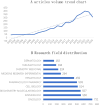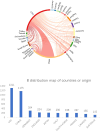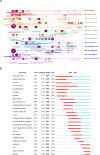A bibliometric and visual analysis of Jak1 to explore trends and frontiers
- PMID: 40746612
- PMCID: PMC12310729
- DOI: 10.3389/fonc.2025.1537508
A bibliometric and visual analysis of Jak1 to explore trends and frontiers
Abstract
Background: JAK1, a member of the JAK kinase family, is involved in the signal transduction of multiple cytokine pathways and is crucial in the onset and progression of inflammation and tumours. Consequently, JAK1 has garnered significant attention in recent years.
Methods: We use bibliometric and visual analysis to evaluate the thematic trends and knowledge structure of TRPV1's research papers on JAK1, sourced from the Web of Science core collection from 2003 to 2024. CiteSpace is used to analyze references and keywords of authors, institutions, countries, and commonly cited, and applies co-current and clustering functions to generate visual knowledge maps.
Results: A total of 3,686 articles were incorporated. The primary research domain of JAK1 is oncology; the United States leads in publication volume, with the University of Texas holding the most prominent central position. The keyword distribution indicates that the literature on JAK1 from 2003 to 2009 primarily concentrated on mechanistic studies, encompassing gene expression, activation, pathways, and cell apoptosis. From 2008 to 2018, research hotspots predominantly examined the association between JAK1 and various disease atlases. Beginning in 2012 and extending to 2024, the focus shifted towards the research and development of clinical pharmaceuticals, along with their safety and efficacy. Gene expression, signal transduction, atopic dermatitis, and JAK1-selective inhibitors have emerged as prominent research areas in recent years, exhibiting significant potential for development.
Conclusion: This study presents the contemporary status and prospective trends of JAK1 research over the last two decades. Current research focuses on skin inflammation, rheumatoid arthritis, and tumor-related diseases, while new signaling pathways are constantly being discovered. JAK1 inhibitors are gradually being used in clinical practice and have good development prospects, which will become the main trend of future research.
Keywords: bibliometric; citespace; jak1; research hotspots; visual analysis.
Copyright © 2025 Yu, Cao, Xie, Chen and Hong.
Conflict of interest statement
The authors declare that the research was conducted in the absence of any commercial or financial relationships that could be construed as a potential conflict of interest.
Figures







Similar articles
-
Research status, hotspots and perspectives of artificial intelligence applied to pain management: a bibliometric and visual analysis.Updates Surg. 2025 Jun 28. doi: 10.1007/s13304-025-02296-w. Online ahead of print. Updates Surg. 2025. PMID: 40580377
-
Knowledge graph and bibliometric analysis of inflammatory indicators in ovarian cancer.Front Oncol. 2025 Jun 30;15:1533537. doi: 10.3389/fonc.2025.1533537. eCollection 2025. Front Oncol. 2025. PMID: 40661780 Free PMC article.
-
Application of non-invasive imaging in myocardial infarction: a bibliometric analysis from January 2003 to December 2022.Quant Imaging Med Surg. 2025 Jul 1;15(7):6340-6359. doi: 10.21037/qims-24-878. Epub 2025 Jun 30. Quant Imaging Med Surg. 2025. PMID: 40727351 Free PMC article.
-
Current status, hotspots and frontiers of ion channel-related research in glioblastoma: a bibliometric analysis from 2005 to 2024.Front Oncol. 2025 Jun 4;15:1588598. doi: 10.3389/fonc.2025.1588598. eCollection 2025. Front Oncol. 2025. PMID: 40535121 Free PMC article. Review.
-
Short-Term Memory Impairment.2024 Jun 8. In: StatPearls [Internet]. Treasure Island (FL): StatPearls Publishing; 2025 Jan–. 2024 Jun 8. In: StatPearls [Internet]. Treasure Island (FL): StatPearls Publishing; 2025 Jan–. PMID: 31424720 Free Books & Documents.
References
Publication types
LinkOut - more resources
Full Text Sources
Research Materials
Miscellaneous

